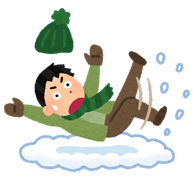Information From CIR CIRからのお知らせ
A consultant for the Miyagi Support Center for Foreign Nationals and a Miyagi Prefectural Coordinator for International Relations(CIR) will share information about daily life in their respective languages from time to time. In addition to information about daily life, they will also share stories about differences between Japan and their respective countries and so on, so please check it out!
みやぎ外国人相談センターの相談員と宮城県の国際交流員(CIR)が、それぞれの言語で生活情報を随時紹介していきます。生活情報の他に、日本とそれぞれの国との違いなどのお話も載せていきますので、ぜひご覧ください!
How to walk safely on winter roads!(12.22.2021)
冬道の安全な歩き方
The temperature is dropping, and snow season is here. Roads can freeze over on cold days, so it’s important to be careful. In particular, there are instances of people slipping and breaking a bone during the first part of winter, when many people aren’t yet used to walking on winter roads. Learning how to walk safely on these roads will give you some peace of mind.
気温が下がり、雪が降る季節になってきました。寒い日は道路が凍ることがありますので、注意が必要です。特に冬の初めの時期は雪道に慣れていない人が多く、転倒して骨折人もいるようです。どうすれば冬の道を安全に歩くことができるか知っておくと安心です。
◎What places are the most slippery?
The road tends to be trampled in places that people and vehicles often travel on, making many of these places smooth and slippery, so keep this in mind. Some examples are crosswalks (especially on the white lines), roads with entrances and exits for cars, stops for busses and taxis, places with tiled floors, entrances and exits of buildings, and areas around a subway entrance and exit.
◎どんな場所が滑りやすい?
人や車がたくさん通るところは、雪道が踏み固められやすいです。そういった場所は滑りやすい、つるつるとした路面になっていることが多いので注意した方がいいです。
例)横断歩道(特に白い線の上)や車の出入りのある歩道、バスやタクシーの乗降場所、床がタイル張りの場所や建物の出入り口、地下鉄などの出入り口付近など
◎How to walk without slipping:
・Take small steps
・Try to use the entire sole of your foot when taking steps
・Give yourself plenty of time to get where you’re going and don’t hurry
◎滑りにくい歩き方
・小さな歩幅で歩く
・できるだけ足の裏全体を使って歩く
・急がず時間に余裕を持って歩く
◎Things to keep in mind:
・Allow yourself plenty of time when traveling
・Be sure to stay focused when walking
・Avoid walking with both hands full or with both hands in your pockets
・Wear slip-resistant shoes
◎心がけること
・時間に余裕をもって移動する
・歩くことに集中する
・両手に荷物を持ったり、両手をポケットにしまった状態で歩かない。
・滑りにくい靴を履く
A CIR’s Perspective:《CIRから》
Adjusting to winter weather can be difficult, especially for those of us from places where winters are mild, or even nonexistent. As someone from sunny California, Japan’s winters are much harsher than the winters I grew up with, where icy roads and snowy weather were not an issue. I didn’t have to buy my first pair of snow boots until I was an adult, experiencing my first winter Japan! It certainly takes some getting used to, but even for those who aren’t used to ice and snow, by keeping the above advice in mind you too can safely enjoy this special season.
Reference:
Sapporo! A Comprehensive Guide to Walking Safely and Comfortably on Winter Roads
【参考】
『札幌発!冬みちを安全・快適に歩くための総合ガイド』
http://tsurutsuru.jp/index.html


About preparation for the earthquake(12.10.2021)
地震への備えについて
Japan is a country where earthquakes occur often. Since we do not know when and where an earthquake will happen, it is necessary to always be prepared. Let us introduce you to information about earthquake preparedness taken from the Miyagi Prefectural Government’s multilingual Disaster Preparedness Handbook for Foreign Residents. The Disaster Preparedness Handbook for Foreign Residents contains information in eight different languages. (English, Chinese, Korean, Tagalog, Vietnamese, Nepalese, Indonesian, and Japanese)
日本は地震が多い国の一つです。地震はいつどこで起こるかわらないため、日頃から地震に備えておく必要があります。宮城県で作成している、『外国人県民のための防災ハンドブック』から、地震への備えについてご紹介します。
※『外国人県民のための防災ハンドブック』8か国語(英語、中国語、韓国語、タガログ語、ベトナム語、ネパール語、インドネシア語、日本語)でご覧いただけます。
◎The Main Types of Natural Disasters and What To Do When They Happen (Be sure to read this to see what you should do when an earthquake happens!)
主な災害と対処方法(地震が起きたらどうしたらよいか確認しておきましょう!
https://www.pref.miyagi.jp/documents/7445/680621.pdf (Japanese, English, Chinese, Korean, Tagalog)
https://www.pref.miyagi.jp/documents/7445/680622.pdf (Japanese, English, Vietnamese, Nepalese, Indonesian)
◎Preparing for Disasters (Take comfort in knowing you’re always prepared!)
災害への備えについて(日頃から備えておくと安心です)
https://www.pref.miyagi.jp/documents/7445/680624.pdf (Japanese, English, Chinese, Korean, Tagalog)
https://www.pref.miyagi.jp/documents/7445/680625.pdf (Japanese, English, Vietnamese, Nepalese, Indonesian)
◎When Disaster Strikes (Contains Japanese words and phrases that you can actually use when disaster strikes)
災害が起きたら(実際に災害が起きた時にすぐに使える日本語などを紹介しています)
https://www.pref.miyagi.jp/documents/7445/680626.pdf (Japanese,English,Chinese,Korean,Tagalog)
https://www.pref.miyagi.jp/documents/7445/680627.pdf (Japanese, English, Vietnamese, Nepalese, Indonesian)
《From CIR》About the difference between Japan’s wind and flood damage and home country
相談員からのコメント
Though California is known for its many earthquakes, my hometown of Sacramento rarely feels even a tremor, so it wasn’t until I moved to Japan that I experienced my first earthquake. I knew before coming to Japan that it is a country prone to earthquakes and other natural disasters, so I made sure to read up on where to evacuate to in case of an emergency and other information in order to be prepared as possible in the event of an earthquake or any other natural disaster. When I finally felt my first tremors, I was a little scared, but I also felt reassured that I knew exactly how and where to evacuate to if the earthquake turned out to be serious. Thankfully, it was just a small one, and I have not experienced a major natural disaster in Japan, but I also take comfort in knowing that I am prepared.
カリフォルニア州は地震が多いことで知られている一方、私の出身地のサクラメントではその地震の揺れを感じることは滅多にない。そのため、初めて地震を体験したのは日本でのことでした。日本は地震などの自然災害が多い国だと知っていたので、地震やその他の自然災害が起きた時にできるだけ備えるために、避難場所がどこにあるかなどを調べておきました。初めて地震の揺れを感じた時は少し怖かったですが、万が一の場合どうすればいいかを先に調べておいたので安心できました。幸いなことにまだ大きい地震などを体験していないのですが、備えあれば憂いなしですね。

